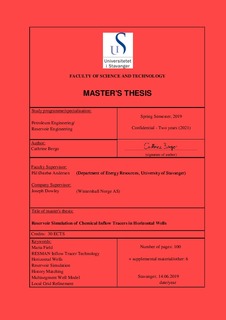| dc.description.abstract | Conventional production logging tools can be challenging to deploy and interpret in long horizontal wells. Inflow tracer technology can address these challenges, by allowing continuous monitoring of the horizontal section. These oil and water activated tracers are permanently embedded into the sandscreen completion of the Maria field producer H-4. The quantitative inflow contribution, obtained from the unique tracers, is interpreted at two well events; Initial clean-up and after six months of production. All zones were contributing to inflow during clean-up, while samples after restart showed no/minor heel contribution, which is not fully understood. This study aims to demonstrate how inflow profiles from tracer data can be used in a simulation model and how the inflow behavior of H-4 can be explained.
To improve the prediction of the existing Maria reservoir model, it is history matched against interpreted tracer inflow profile, in addition to the traditionally used matching parameters; Pressure and oil production rate. By tuning the horizontal permeability and porosity, within acceptable margins, good matches to the clean-up profile were achieved. Less satisfactory matches were achieved to the restart profile, giving no clear explanation of the mechanism causing such behavior. No major reduction in the well productivity could indicate that the heel zones are really flowing during restart, but the tracer signals are lost somehow.
To increase the understanding of the complex reservoir model, a simplified model was constructed, based on assumptions of single-phase oil and Darcy’s law with radial geometry at steady state conditions. Interpretation using both models imply a higher permeability trend in zones with higher inflow. The simplifying assumptions of constant reservoir pressure and depth of the horizontal section are considered to have greatest impact on the oil rate results. Thus, by taking these into account, higher accuracy of drawdown and hence, permeability distribution, is expected. The reservoir model, on the other hand, takes more parameters, mechanisms and equations into account. Hence, it is more representative of real systems.
Considering the multisegment well option in the Maria reservoir model, it was concluded that the pressure losses of producer H-4 have a minor impact on the reservoir model results. Moreover, from a sensitivity study of Local Grid Refinement around the H-4 wellbore, it was concluded that the current grid blocks are appropriate to capture the dynamic trends of the reservoir | nb_NO |
